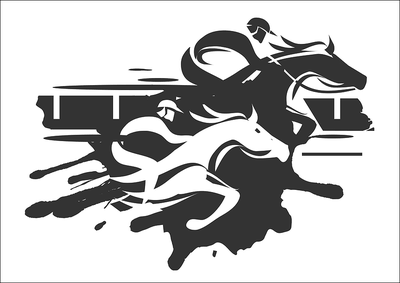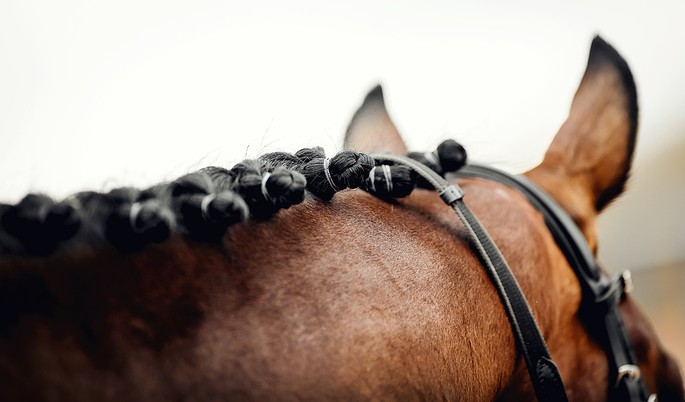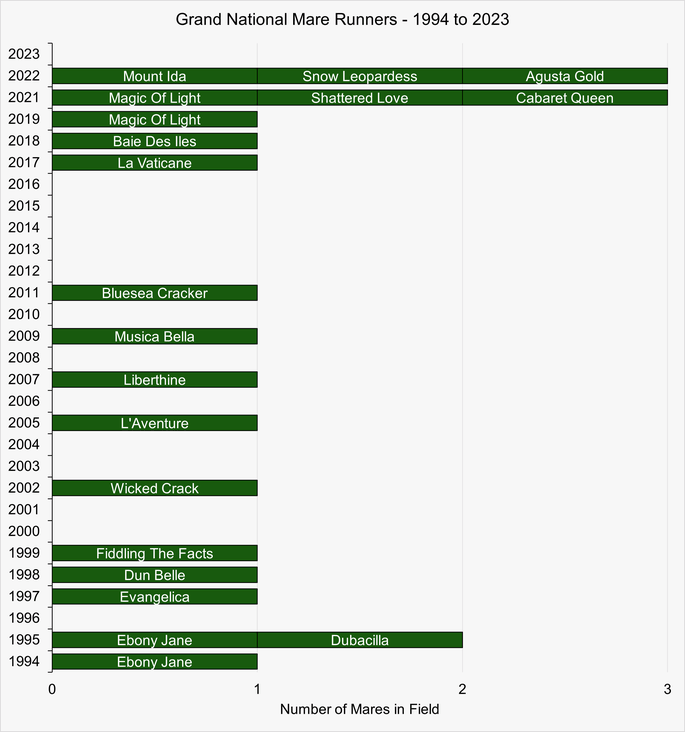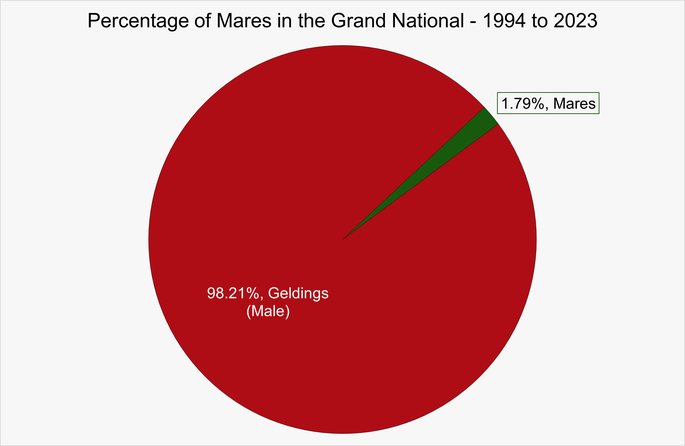 When the Grand National comes around, punters look for a reason to pick one horse over another. With typically large fields, the ‘World’s Greatest Steeplechase’ often feels as though it could be anybody’s, such is the fast and furious nature of the event. Some people will look for names that stand out to them, maybe betting on ‘Mildred’s Way’ because they love their aunt Mildred, or placing a wager on a horse because the jockey is wearing silks that are the bettor’s favourite colour. For some people, it is the gender of the horse that can be the deciding factor.
When the Grand National comes around, punters look for a reason to pick one horse over another. With typically large fields, the ‘World’s Greatest Steeplechase’ often feels as though it could be anybody’s, such is the fast and furious nature of the event. Some people will look for names that stand out to them, maybe betting on ‘Mildred’s Way’ because they love their aunt Mildred, or placing a wager on a horse because the jockey is wearing silks that are the bettor’s favourite colour. For some people, it is the gender of the horse that can be the deciding factor.
As a result, many bets are often placed on mares when the Aintree race comes around, in spite of the fact that the evidence suggests that such a bet might not be the wisest. Mares tend not to do as well as geldings and stallions in the race, but why might that be the case? Is it because female horses don’t tend to be as capable as male horses of taking on the stresses and strains of a course like the National? Or is it more a case of there being significantly more male horses that enter so it’s just a matter of numbers? Either way, it’s worth bearing in mind when you bet.
Quick Answer: How Many Mares Have Won the Grand National?
Since the first Grand National in 1839, there have been thirteen winning Mares, 7.43% of all winners. The first was Charity in 1841 and the latest was Nickel Coin in 1951.
Between the last winning mare in 1951 and 2023, ten mares have placed in the top four. Magic Of Light was last mare to be a runner-up in the Grand National when second behind Tiger Roll in 2019.
Between 1994 and 2023, mares made up just 20 of the 1117 runner, 1.79%.
What Is A Mare?

First and foremost, the most important thing that we can do is to explain exactly what a mare is. After all, there is no point writing a big long piece about the number of mares that have won the Grand National if some people reading this might not be entirely sure what a mare actually is. In simple terms, a mare is a female horse that is over the age of three, or four if you’re talking about thoroughbred racing. If they are under three then they are a filly, but that is irrelevant for the Grand National on account of the fact that the minimum age for entry into the race is seven.
The term can be used for other equine animals that are female, such as zebras or mules, although a female donkey is known as a ‘Jenny.’ It is generally considered that mares are easier to handle than a stallion would be, although it is obviously different from case to case. There is also an argument from some that geldings are the easier type of horse to handle, but it can depend entirely on the individual horse. Whilst mares can compete against male horses, with some notable female winners of races like the Prix de l’Arc de Triomphe and the Kentucky Derby, they don’t tend to do as well.
Winning Mares in the Grand National
As proof of the fact that it isn’t impossible for mares to win the Grand National, there have been some successful ones in the past. Here is a look at the race’s winning mares in the events that took place between the race’s first ever running and the 2023 renewal:
List of Grand National Winning Mares – 1839 to 2023
| Year | Winning Mare | Age | Weight | Jockey | Trainer |
|---|---|---|---|---|---|
| 1951 | Nickel Coin | 9 | 10-1 | John Bullock | Jack O’Donoghue |
| 1948 | Sheila’s Cottage | 9 | 10-7 | Arthur Thompson | Neville Crump |
| 1902 | Shannon Lass | 7 | 10-1 | David Read | James Hackett |
| 1889 | Frigate | 11 | 11-4 | Tommy Beasley | M. A. Maher |
| 1883 | Zoedone | 6 | 11-0 | Charles Kinsky | W. Jenkins |
| 1880 | Empress | 5 | 10-7 | Tommy Beasley | Henry Linde |
| 1872 | Casse Tete | 7 | 10-0 | John Page | A. Cowley |
| 1864 | Emblematic | 6 | 10-6 | George Stevens | Edwin Weever |
| 1863 | Emblem | 7 | 10-10 | George Stevens | Edwin Weever |
| 1861 | Jealousy | 7 | 9-12 | Joseph Kendall | Charles Balchin |
| 1860 | Anatis | 10 | 9-10 | Tommy Pickernell | H. E. May |
| 1852 | Miss Mowbray | 7 | 10-4 | Alec Goodman | George Dockeray |
| 1841 | Charity | 11 | 12-0 | Horatio Powell | William Vevers |
As you can see, there have been 13 mares that have won the National to date, although all but three of them did so in the 19th century. In terms of the modern area, no mare has managed to win since Nickel Coin managed it and that was back in 1951. There have been 175 Grand Nationals at the time of writing, meaning just 7.43% of the winners have been mares.
Mares That Have Come Close
Whilst the list of winning mares is quite short, it doesn’t grow to be too much longer even if you add in the horses that came close but just missed out. Here is a look at the female horses that narrowly missed out on Grand National glory between the last winner in 1951 and 2023:
List of Grand National Placed Mares – 1952 to 2023
| Year | Horse | Position | Distance to Winner |
|---|---|---|---|
| 2019 | Magic of Light | 2nd | 2¾ Lengths |
| 1995 | Dubacilla | 4th | 13½ Lengths |
| 1994 | Ebony Jane | 4th | 46¼ Lengths |
| 1991 | Auntie Dot | 3rd | 13 Lengths |
| 1977 | Eyecatcher | 3rd | 31 Lengths |
| 1976 | Eyecatcher | 3rd | 10 Lengths |
| 1970 | Miss Hunter | 3rd | 20½ Lengths |
| 1958 | Tiberetta | 2nd | 15 Lengths |
| 1957 | Tiberetta | 3rd | 14 Lengths |
| 1956 | Gentle Moya | 2nd | 10 Lengths |
You can see, then, that even when we take horses that have only just missed out on winning the National into account, mares don’t do all that well in the ‘World’s Greatest Steeplechase.’ Presuming that the the horses that finished fourth had no real chance of winning but that those that came second and third might well have done with a bit of fortune, we can see that seven more horses could be added to the list of ‘winners’ of the race. That would make it 20 ‘winners’ from the 175 races that we’re looking at, or 11.43% of all winners that would’ve been mares.
Does National Experience Make A Difference?
A question that might be worth asking is whether the experience of the mares running in the Grand National make any difference to their ability to win the race. The answer is, probably not. Six of the 13 winners managed it at the first time of asking, whilst plenty of the horses that came close but missed out had a good amount of National experience. Here is a look at each of the winners as well as the placers, matched with their record in the race:
Charity – Complete Grand National Record
| Year | Going | Position |
|---|---|---|
| 1839 | Heavy | Fell |
| 1841 | Good to Soft | Winner |
| 1844 | Heavy | Pulled Up |
Charity ran in the Grand National three times, with the first occasion being the official debut of the event in 1839 where she unseated her rider. She ran again two years later, winning it, then three years after that when she pulled up.
Miss Mowbray – Complete Grand National Record
| Year | Going | Position |
|---|---|---|
| 1852 | Good | Winner |
| 1853 | Soft | Second |
| 1855 | Soft | Fell |
Miss Mowbray also ran in the National on three occasions. Interestingly, she won on her debut in the event in 1852, suggesting that experience of the Aintree course wasn’t crucial to success. She ran again a year later and came second, then in 1855 she took part once again but sadly suffered a fatal fall.
Anatis – Complete Grand National Record
| Year | Going | Position |
|---|---|---|
| 1859 | Good | Fifth |
| 1860 | Good | Winner |
| 1861 | Good to Soft | Pulled Up |
| 1862 | Good | Pulled Up |
The most experienced of the horses that we’ve looked at so far, Anatis’ first experience of the Grand National came in 1859 when she finished 5th. The following year she won the race, then in the two years that followed she pulled up.
Jealousy – Complete Grand National Record
| Year | Going | Position |
|---|---|---|
| 1859 | Good | Eleventh |
| 1861 | Good to Soft | Winner |
| 1863 | Good to Firm | Sixth |
Jealousy’s first experience of the Grand National came in 1859 when she came 11th. She won the race two years later, then came sixth two years after that.
Emblem – Complete Grand National Record
| Year | Going | Position |
|---|---|---|
| 1863 | Good to Firm | Winner |
| 1865 | Soft | Pulled Up |
Another example of how experience might not be all that necessary to a Grand National win comes in the form of Emblem. She won the race at the first time of asking in 1863, then two years later she pulled up.
Emblematic – Complete Grand National Record
| Year | Going | Position |
|---|---|---|
| 1864 | Soft | Winner |
| 1865 | Soft | Third |
It isn’t easy to find out whether there is a link between Emblem and Emblematic, though is is reported that they were half-sisters. The one thing we do know id that they won successive Grand Nationals. Emblematic, like her predecessor, also won her debut in the race. She ran again a year later and finished third.
Casse Tete – Complete Grand National Record
| Year | Going | Position |
|---|---|---|
| 1870 | Good to Firm | Pulled Up |
| 1871 | Good to Firm | Fourteenth |
| 1872 | Firm | Winner |
| 1873 | Good | Pulled Up |
| 1874 | Good to Soft | Fell |
So far, four is the most races that one of our mares has run in in terms of Grand Nationals, but Casse Tete went one step further and ran in five. That is in spite of the fact that she pulled up at the first time of asking and then came 14th next time out, eventually winning in go number three. She pulled up a year later and then fell a year after that.
Empress – Complete Grand National Record
| Year | Going | Position |
|---|---|---|
| 1880 | Good | Winner |
From the most entries we’ve had so to the fewest. Empress entered the Grand National just once, winning the race at the first time of asking and never returning.
Zoedone – Complete Grand National Record
| Year | Going | Position |
|---|---|---|
| 1852 | Heavy | Third |
| 1883 | Heavy | Winner |
| 1884 | Good | Sixth |
| 1885 | Good | Fell |
Zoedone’s first entry into the Grand National came in 1882 when she finished third. That was enough to get her owners to enter her into it again a year later when she won it. A year after that she came sixth, then her final entry came in 1885 when she fell.
Frigate – Complete Grand National Record
| Year | Going | Position |
|---|---|---|
| 1884 | Good | Second |
| 1885 | Good | Second |
| 1886 | Good to Soft | Unseated Rider |
| 1887 | Good | Pulled Up |
| 1888 | Good to Soft | Second |
| 1889 | Good | Winner |
| 1890 | Soft | Fell |
Frigate managed an impressive seven entries into the Grand National, as though her owners knew that she could be a winner. That might well be because her first two entires in 1884 and 1885 saw her finish second. She unseated her rider and then pulled up in the two years that followed before managing another second place in 1888. She finally got her win a year after that and then fell in 1890.
Shannon Lass – Complete Grand National Record
| Year | Going | Position |
|---|---|---|
| 1902 | Good to Soft | Winner |
Time for another horse who not only won the race at the first time of asking but also never bothered to come back, happy with her lot. Shannon Lass won the event in 1902 and never ran in it again.
Sheila’s Cottage – Complete Grand National Record
| Year | Going | Position |
|---|---|---|
| 1947 | Heavy | Fell |
| 1948 | Good | Winner |
Sheila’s Cottage’s owners might have been forgiven for not entering the horse again, given the fact that she fell at fence 12 in 1947, her debut in the race. A year later, though, she was back and won the Grand National, never entering it again.
Nickel Coin – Complete Grand National Record
| Year | Going | Position |
|---|---|---|
| 1951 | Soft | Winner |
The most recent mare to win the race did so in 1951, which was the one and only time that she ran in it.
Gentle Moya – Complete Grand National Record
| Year | Going | Position |
|---|---|---|
| 1954 | Good | Fell |
| 1955 | Heavy | Sixth |
| 1956 | Good | Second |
| 1957 | Good | Eleventh |
Onto our list of mares that came close but didn’t quite manage the win now, with Gentle Moya entering the Grand National four times. The first was in 1954 when she fell at the first fence, then she came sixth a year later and got her second place finish in 1956. She finished 11th in 1957, which was her final outing.
Tiberetta – Complete Grand National Record
| Year | Going | Position |
|---|---|---|
| 1957 | Good | Third |
| 1958 | Soft | Second |
| 1959 | Good | Fourth |
If you were placing Each-Way bets on Tiberetta you would have at least got some money back over the years. Her first race in 1957 saw her come third, then she came second a year later and fourth in 1959.
Miss Hunter – Complete Grand National Record
| Year | Going | Position |
|---|---|---|
| 1969 | Firm | Tenth |
| 1970 | Good | Third |
| 1971 | Good | Fell |
| 1972 | Good to Soft | Pulled Up |
The experience of Miss Hunter saw her finish tenth when she ran in 1969, then she got her best finish in 1970 when she came third. A year later she fell, perhaps explaining why she pulled up a year after that.
Eyecatcher – Complete Grand National Record
| Year | Going | Position |
|---|---|---|
| 1976 | Good | Third |
| 1977 | Good | Third |
If there’s one thing you can say about Eyecatcher it’s that she was consistent. She ran in the Grand National twice, in 1976 and 1977, finishing third both times.
Auntie Dot – Complete Grand National Record
| Year | Going | Position |
|---|---|---|
| 1991 | Good to Soft | Third |
| 1992 | Good to Soft | Sixteenth |
One of those horses that countless people with a family member called Dorothy might well have bet on, Auntie Dot came third in 1991 and then 16th in 1992.
Ebony Jane – Complete Grand National Record
| Year | Going | Position |
|---|---|---|
| 1994 | Heavy | Fourth |
| 1995 | Good | Twelfth |
In 1994, Ebony Jane took part in the Grand National for the first time and came fourth. If her owners felt that might have been an underperformance then they will have been disappointed when she came 12th a year later.
Dubacilla – Complete Grand National Record
| Year | Going | Position |
|---|---|---|
| 1995 | Good | Fourth |
For some owners, the experience of seeing their horse run in the Grand National must be so scary as to mean that they don’t want to go through it again. Perhaps that is what happened with Dubacilla, who came fourth in 1995 then never took part in the race after that.
Magic of Light – Complete Grand National Record
| Year | Going | Position |
|---|---|---|
| 2019 | Good to Soft | Second |
| 2021 | Good to Soft | Unseated Rider |
The most recent mare to finish in the places in terms of the time period that we’re looking at was Magic of Light, who came second in 2019. She ran again two years later but unseated her rider at the fourth. Sadly for her, she was up against Tiger Roll, who matched Red Rum’s record of two successive victories in the race.
The Number of Mare Runners
When trying to figure out why a mare might or might not have done well in the Grand National, it is important to consider how many female horses have taken part in the ‘World’s Greatest Steeplechase.’ After all, if there are 40 horses running and 39 of them are male, it is hardly all that surprising that the mare failed to win purely in terms of numbers. The mare would not only need to be an exceptional runner but also have everything going for them in order to see them finish first. Here is a look at how many mares have run in the race over the period of 1994 to 2023, which was the last point at which we can find gender information of the horses:

You can see that over the period of time that we’re looking at, there were 29 Grand Nationals. During those races, 1,117 horses ran. Of those, just 20 were mares.

In other words, a mere 1.79% of the total horses that ran in Grand Nationals across the 29 races in question were mares. Given the fact that less than 2% of all of the horses were female, it is perhaps not all that surprising that none of them managed to win the race and that some of them managed to place is quite impressive in and of itself.
